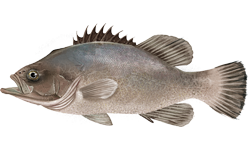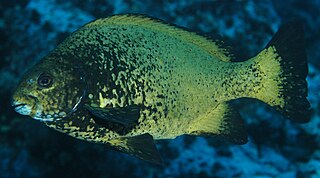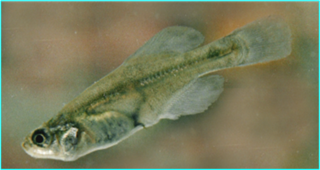
Acropomatidae is a family of fish in the order Perciformes, commonly known as lanternbellies. Acropoma species are notable for having light-emitting organs along their undersides. They are found in all temperate and tropical oceans, usually at depths of several hundred meters. There are about 32 species in as many as 9 genera, although some authorities recognise fewer genera than Fishbase does.

Holacanthus is a genus of marine angelfishes. The eight species are particularly abundant near volcanic rocks and coral islands. Some are highly valued as food, but even more so for aquaria, as all are brightly colored.

The wreckfish are a family, Polyprionidae in the suborder Percoidei of the order Perciformes.

The sea chubs, also known as rudderfish and pilot fish and in Hawaiian as enenue or nenue, are a family, Kyphosidae, of fishes in the order Perciformes native to the Atlantic, Indian and Pacific Oceans usually close to shore in marine waters.

Stichaeidae, the pricklebacks or shannies, are a family of marine ray-finned fishes in the suborder Zoarcoidei of the order Scorpaeniformes. Most species are found in the North Pacific Ocean with a few in the North Atlantic Ocean.

Crenimugil is a genus of mullets found in coastal marine waters and rivers in the Indo-Pacific region.

Characodon is a genus of splitfins endemic to north–central Mexico. Two of the species are highly threatened and restricted to pools, ponds and springs in the upper San Pedro Mezquital River basin in Durango. The third species, C. garmani, was restricted to springs near Parras in Coahuila, but it became extinct when they dried out.

Dermatolepis is a genus of marine ray-finned fish, groupers from the subfamily Epinephelinae, part of the family Serranidae, which also includes the anthias and sea basses. They are found in the western Atlantic, Pacific and Indian Oceans.

The Chapultepec splitfin, known locally as mexcalpique, is a critically endangered species of fish in the family Goodeidae. It is endemic to Mexico and was originally restricted to lakes and wetlands in the Valley of Mexico, including Lake Texcoco. Through man-made channels it was able to spread to the upper Pánuco River basin. Most native populations disappeared as they were at or near Mexico City, with the waters either being reclaimed, drained, heavily polluted or infested with introduced species. Today the Chapultepec splitfin is only known to survive in three lakes in the Chapultepec park of Mexico City, Lake Xochimilco, Lake Zumpango, Laguna de Tecocomulco northeast of the City where perhaps introduced, and parts of the Pánuco River basin. Most of these remaining populations are small. This species was originally described as Cyprinus viviparus in 1837 by Miguel Bustamante y Septién with the type locality given as "Mexico". In 1860 Pieter Bleeker raised the genus Girardinichthys with a new species Girardinichthys viviparus as its type species, this subsequently proved to be a taxonomy of Cyprinus viviparus.

Plectropomus, commonly known as the coral groupers, is a genus of marine ray-finned fish, groupers from the subfamily Epinephelinae, part of the family Serranidae, which also includes the anthias and sea basses. They are found in the Indo-Pacific region.

Bangana is a genus of fish in the family Cyprinidae, the carps and minnows. It is distributed across much of southern and eastern Asia. Species live mainly in the flowing waters of tropical and subtropical rivers.

Fodiator is a genus of flying fishes. It is the only genus in the subfamily Fodiatorinae.

Synbranchus is a genus of swamp eels native to Central and South America.
Menziesichthys is a genus of marine ray-finned fishes belonging to the family Liparidae, the snail fishes. These are deep water fishes found in the Pacific Ocean.
Osteodiscus is a genus of snailfishes native to the Pacific Ocean.

Pseudocaranx is a genus of ray-finned fishes from the family Carangidae, the jacks, trevallies, scads, and pompanos. They occur in the western Atlantic Ocean and the Indo-Pacific.

Selene is a genus of carangids, commonly known as lookdowns and moonfishes, native to the Atlantic Ocean and the eastern Pacific Ocean.

Belobranchus belobranchus, the throat-spine gudgeon, is a species of fish in the family Eleotridae native to Indonesia, the Philippines, New Guinea, Timor-Leste, Solomon Islands, New Caledonia and Fiji where it can be found in fresh and brackish water in coastal streams and estuaries. This species grows to a length of 19.5 cm (7.7 in). This species was the only known member of its genus, until Belobranchus segura was described in 2012.
Belobranchus segura is a species of eleotrid sleeper goby which has been found in Indonesia on Halmahera, in Papua Barat and also on the Solomon Islands. It is an anadromous species in which the eggs are laid over rocky and gravel bottoms in freshwater streams. The free-swimming larvae then drift downstream to the sea where they undergo a planktonic stage before migrating up streams to mature and breed. It feeds on small crustaceans and fish. The specific name honours the French hydrobiologist Gilles Segura for his contribution to the study of fish faunas.

Pelates, is a genus of fish in the family Terapontidae, containing 3 species in it.

















